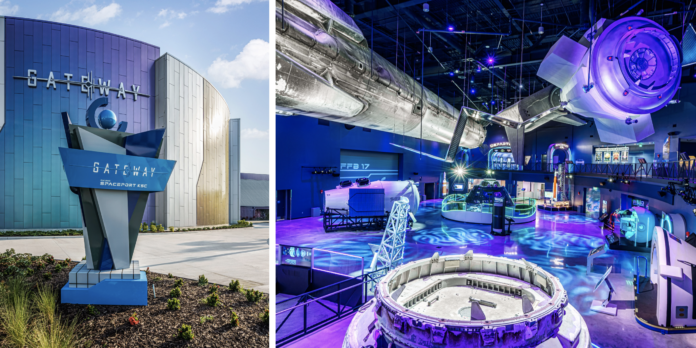When Kennedy Space Center Visitor Complex (KSCVC), set out to create its newest attraction, Gateway: The Deep Space Launch Complex, they turned to longtime partner BRPH, a nationally ranked architecture, engineering and construction firm, for its creative and technical expertise as well as its experience in handling and displaying priceless space artifacts. The new attraction opened last week, immersing guests in the present and future of collaborative space exploration via a thrilling two-story motion theater experience, Spaceport KSC, and a showcase of priceless NASA and commercial space hardware and displays.
BRPH worked alongside NASA and Delaware North Parks & Resorts at KSC (DNCPR) from the inception of the project in 2017, helping the clients develop the vision for the attraction. The design marks a new era in entertainment architecture and design in which agility and adaptability are essential to maintaining the relevancy of the forward-looking attraction. While other areas of Kennedy Space Center Visitor Complex highlight the past achievements of NASA’s Mercury, Gemini, Apollo and Space Shuttle programs, the 50,000-square-foot Gateway: The Deep Space Launch Complex was conceived to evolve and adapt along with the space industry. Much more than a static display, the attraction is designed to accommodate whatever artifacts, hardware and exhibits may be introduced in the years ahead.
“We could not be more pleased with the vision, creativity and technical skill provided by our longtime partners at BRPH on our newest attraction, Gateway: The Deep Space Launch Complex,” said Therrin Protze, chief operating officer of Kennedy Space Center Visitor Complex.
Agility in Design
During the design phase, BRPH faced the challenge of planning for a 160-foot long commercial space rocket booster to be suspended above the exhibit floor. The building plan accommodated an open wall through which the artifact, the width of a football field and 12-feet in diameter, could be expertly guided into place prior to completion of the ingress point. The twice-flown, first stage appears as if floating overhead with the use of a custom-engineered, high-strength “tri-pyramid” cable system.
The twice-flown artifact is still scorched and discolored from its two launches and landings—perfect for display and guaranteed to bring the “wow” factor.
To accommodate any new artifact or hardware acquisitions in years to come, BRPH designed a vehicle prep room at the rear of the attraction, outfitted with interior and exterior sets of 28-feet-wide by 20-feet-tall high bay doors. Through this “backstage” entrance, artifacts and hardware can be received, stored and prepared for display without interrupting the guest experience, before being moved on or off the exhibit floor. An air pallet system around the perimeter of the Exhibit Hall uses a cushion of compressed air to create a hover effect, allowing easier movement of items like the Orion crew capsule, which was built to accommodate four astronauts and weighs a whopping 8.5 metric tons or nearly 19,000 pounds. This technology is similar to that used in NASA’s Operations and Checkout building where the Orion capsule is processed—a facility BRPH also designed. A 10-ton bridge crane is permanently installed between the two sets of high bay doors to help move heavy artifacts such as the capsules. Multiple power and data systems were strategically placed throughout the Exhibit Hall floor for added flexibility. Interior elements such as display railings are demountable to allow further clearance and design adaptability.
“We were thrilled to once again partner with Kennedy Space Center Visitor Complex on their newest attraction,” said Francisco Alvarado, AIA, NCARB, vice president and principal at BRPH. “Our depth and breadth of experience across many industries, including our extensive portfolio of work for NASA, put BRPH in a unique position to draw on our bank of experience, yet deliver creative new solutions that address the visitor complex’s needs for flexible space. We’re proud to have designed an attraction that will evolve with the future of space travel and thrill visitors for years to come.”
A Storied History
After the close of the NASA’s Space Shuttle program, BRPH was called upon to provide structural, civil and MEP engineering for the Space Shuttle Atlantis® attraction at Kennedy Space Center Visitor
Complex, helping to create a permanent home for the retired 153,996-pound orbiter which is displayed as if floating in space. The firm also designed Heroes & Legends featuring the U.S. Astronaut Hall of Fame® presented by Boeing, in which a 68-foot-long Mercury Redstone rocket is suspended from the roof structure.
BRPH shares a long history with NASA, as it was established in 1964 in direct support of the Apollo program. Since then, BRPH has provided architecture and engineering services for launch complexes at Kennedy Space Center (KSC) and around the world. The firm also has worked on substantial refurbishing projects inside the Vehicle Assembly Building and other KSC structures.
BRPH also brought several decades of entertainment and theme park experience to the job, with its resume including iconic rides such as Hagrid’s Magical Creatures Motorbike Adventure™, Remy’s Ratatouille Adventure, Sesame Street Land™ at SeaWorld Orlando, TRANSFORMERS™ 3D: The Ride, Race Through New York starring Jimmy Fallon, and many more.
The AEC firm’s experience with the transportation and coordination of large vehicles and rockets, as well as with industrial equipment such as bridge cranes and air pallet systems, was also a tremendous asset, providing added reassurance to NASA and commercial space companies like SpaceX that its priceless artifacts were indeed in good hands.







